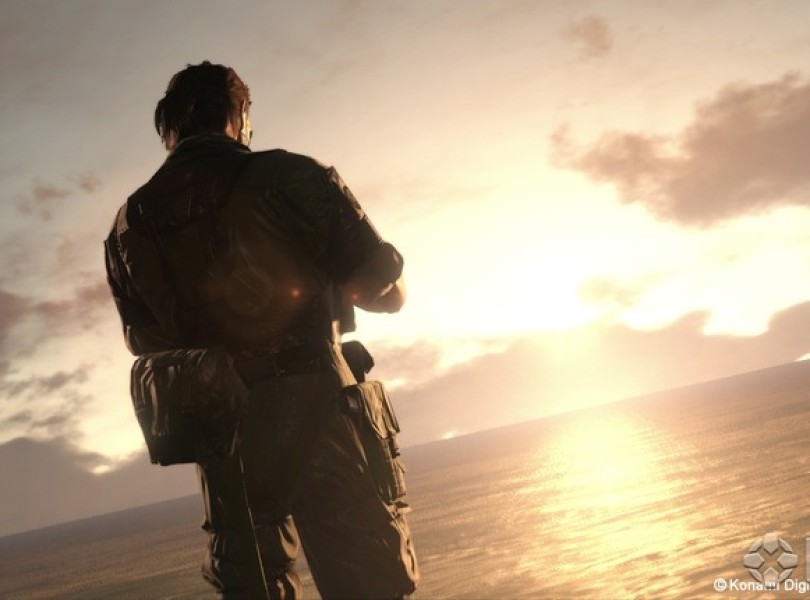→ August 23, 2015
I had planned it all very carefully. There were way too many guards still looking for me, and with sunrise coming shortly, I had almost no chance of making it out to the nearest safe landing zone with an injured prisoner on my shoulders. But I wouldn’t have to. During the night, I planted some C4 on this outpost’s radio communication equipment, the anti-aircraft battery, and most importantly, their AA radar. So I took a deep breath, detonated all three at once, called in a chopper, and watched it all unfold. After a short while, my ride swooped in, blasting an APC to bits with a ferocious rocket barrage, and cutting infantry down with heavy machine gun fire as I scrambled from my hiding place to the main courtyard, prisoner in tow. I hopped in with my precious cargo, and then jumped on the side-mounted minigun to keep the newly arrived reinforcements at bay as my chopper smoked and sputtered its way out of the hotzone.
That’s Metal Gear Solid V: The Phantom Pain almost all the time, and what’s truly incredible is that none of this escape was scripted or directed. My mission was simply to get that prisoner out alive. The rest of it, from the time of day I chose to approach to crippling the base’s ability to deal with an aerial assault was a testament to how perfectly all the pieces of Phantom Pain’s gameplay fit together. It is, unquestionably, my favorite Metal Gear to play, though I do wish its story delivered as many memorable moments as its sandbox empowered me to create for myself.
Right from the moment you’re told to get on your horse and explore the Afghan countryside, Phantom Pain feels intimidating, almost overwhelming in terms of the freedom its open world affords and the number of concepts it expects you to grasp. It’s almost too much, especially given the relative linearity of previous Metal Gears. But what initially appeared to be an overly dense tangle of features to fiddle with instead unraveled into a well integrated set of meaningful gameplay systems that provided me with a wealth of interesting decisions to make.
Let’s take another look at my daring prisoner rescue for instance. Phantom Pain’s day/night cycle and dynamic weather played a big role in my decision to pull the trigger on that C4. While I knew I wouldn’t have the cover of night, I was also fairly certain I wouldn’t have fog, a sandstorm, or even a little rain to make my footsteps harder to hear, because my intelligence team back at my base forecasted the weather in advance. I also knew that I needed a closer extraction point, so I sought out that anti-air radar to open one up. Then there was the comms equipment, which I messed up on. Since I didn’t destroy all of the transmitters, reinforcements from nearby outposts came to complicate things at the end. The number of different factors to consider makes every bad situation you find yourself in a fun puzzle to solve.
More importantly though, you’re free to solve those puzzles your own way because of how flexible Phantom Pain’s core gameplay is. The transition between careful stealth and going loud is a lot more organic than in any previous MGS, and getting aggressive never feels “wrong” the way it often does in stealth games. If someone spots you, you get a few seconds of slow motion (called Reflex Time) to take them down silently and prevent a full combat alert. Not only does this create a lot of tense, sweet-looking movie moments, but it gives you the freedom to take calculated risks with room for exciting mistakes.
Even when things do get out of hand, missions progress accordingly. Your carefully planned sneaking mission might turn into you chasing down a fleeing target on horseback, or a white-knuckle showdown with an enemy gunship instead, but going “off-script” isn’t a one-way ticket to failure and frustration.
The fact that it’s relatively painless to experiment and get a little (or even extremely) aggressive makes playing with the many fun toys Phantom Pain provides a literal blast. I can call in a gunship for close air support, designate targets for a massive sleeping gas bomb, or have a customizable combat walker dropped in for me to wreak havoc with. Gunplay feels responsive, direct, and so very right, and unlike Ground Zeroes, I can use all this stuff guilt-free since it doesn’t completely tank my mission ratings.
That isn’t to say that playing like a trigger-happy maniac doesn’t have ramifications, because it most certainly does, thanks to Phantom Pain’s fantastic base-management layer, Mother Base, which is far deeper and and more detailed than it has any reasonable excuse to be. It’s essentially the full realization of all the good ideas Peace Walker seeded. From Mother Base, you manage the construction, staffing, and R&D needs of your growing mercenary group, the Diamond Dogs. Every soldier I kill and every supply truck I mercilessly blow up in the field is missed potential. In other games, enemy outposts are simply filled with threats to be eliminated, but in Phantom Pain they are opportunities to gain resources and new recruits.


Advertisement
Advertisement
Advertisement
Advertisement
Advertisement
Advertisement
And as it turns out, it takes a whole lot of money, manpower, and materials to run a successful private military corporation. There’s an outrageous number of guns, gadgets, and abilities to unlock for yourself, and for the vehicles and sidekicks you’ll employ throughout the story campaign – and many require you to meet several criteria to snag them. You’ll need to keenly assign new recruits to an arm of your infrastructure suited to their talents, send well-rounded combat groups out on side contracts to keep money coming in, and direct research efforts much like you would in an X-COM campaign. The breadth of options to choose from and decisions to make isn’t the most impressive thing though – it’s the fact that all of it has a relevant, meaningful impact when you head out onto the field.
Granted, re-assigning newly conscripted soldiers across different branches of my base sounds about as sexy as balancing my checkbook, but when, for instance, my R&D team threw me a newly modified version of my favorite assault rifle, or when re-routing personnel into support and logistics led to me gaining access to off-map artillery bombardment, I was glad I took the time to sweat the details. The door swings both ways too: just as those back-end decisions become tangible boons in the field, the choices I make during a mission have ramifications for the resource crunch at home as well.
Resource management is, in fact, the blood coursing through the veins of this open world, giving its many interconnected infiltration spaces their reason to be. While Phantom Pain’s thoughtfully structured sandboxes provided the freedom to sneak by smaller outposts on my way to my primary objective, I rarely did. After all, those unsuspecting guards could have vital intel, and they sure aren’t going to interrogate themselves. They might know the location of a supply truck I could steal to drive into the next base unmolested, or they could spill the location of a talented gunsmith for me to rescue. Sure, it’ll take me out of my way, but I’d finally be able to research that sweet new anti-material sniper rifle I’ve been lusting after. This masterfully woven relationship between The Phantom Pain’s many systems, both management and action-based, elevates its gameplay to a wholly different plane than its many open-world action contemporaries.
However, where Phantom Pain’s gameplay systems are far richer and meatier than any the series has ever seen, its story feels insubstantial and woefully underdeveloped by comparison. It opens confidently, with Director Hideo Kojima ready to fully embrace the techno-fantasy, live-action military anime identity that Metal Gear has been courting for the better part of two decades. This spectacular opening establishes a mood and a bundle of plot-related questions that are more or less abandoned until the time comes, some 30-60 hours later (depending on which answers you’re seeking and how you play). Generally those answers are rushed and unsatisfying, lacking any real build-up or thematic relevance.
This is doubly disappointing in a series known for (sometimes clumsily and exhaustively) exploring its subject matter. The opposite is true here though. The Phantom Pain brings up topics like the personal cost of revenge, child soldiers, and torture to name a few, but it has positively nothing to say about any of them other than that they exist. Thankfully though, it never wasted my time pretending to say more, as cut scenes were sparse and brief, so as to let me get back to playing. As nice as that might be though, I’d rather have the “problem” that Guns of the Patriots had, where there were “too many” awesome moments and plot twists.
For their part, Phantom Pain’s story elements are at least well produced, with beautiful cinematography, and workmanlike performances from everyone, including Keifer Sutherland, who sadly has practically nothing to do as Big Boss. His inexplicable silence through even the most crucial story beats towards the end go beyond mere stoicism, and were positively jarring. Almost gone are the off-topic codec convos, climactic boss battles, and memorable character moments of Metal Gears past. Everyone seems to exist solely to walk on screen, deliver information, and then stand there dramatically.

The only real exception to this is the sniper Quiet, whose warm, childlike sincerity and battlefield ferocity cause her to steal every scene she’s in. Her preposterous lack of clothing undercuts those qualities a fair bit though: one particular moment later in the game comes off a bit creepy instead of endearing solely because of her outfit. You seriously could have put her in generic army fatigues and she would still have been the most interesting character here – the fact that she’s also required to be a lust-object is disappointing.
It’s surprising, though, how little Phantom Pain’s story woes actually impacted my experience with it. It takes an almost completely hands-off approach to both story and gameplay, which means that the lion’s share of the takeaway moments will almost certainly be the ones of your own orchestration. But given how readily Phantom Pain facilitates the creation of those moments, it’s difficult for me to feel bad about that. In a decade, I doubt there will be a single mission I’ll be able to point to and say “remember when you had to do that,” but I could fill a book with stories about how I dealt with a mission going south, or a brilliant plan I came up with that worked just like I thought it should. This is certainly the least “authored” Metal Gear, but it’s also the most player-driven, and I’d gladly take the helicopter escape story I shared earlier over any scripted event or set-piece.
That memory creation doesn’t end with the story missions though. Phantom Pain still has more layers of depth to unfurl with its online Forward Operating Base, which allows you to construct additional fortresses aside from your main Mother Base. You’ll allocate resources, manpower, and fixed defenses that you’ve secured out in the field to defending these bases from online invaders. You’ll also invade the bases of other players in an attempt to secure resources, high-ranking recruits, and most importantly enemy nukes. FOB is, ultimately, about nuclear proliferation, where you can choose to build up a massive WMD stock, or steal and disarm those of others. I only got a couple of hours to mess around with it, but so far it provides ample incentive to continue to explore and plunder Phantom Pain’s sizeable sandboxes well after the credits have rolled.


